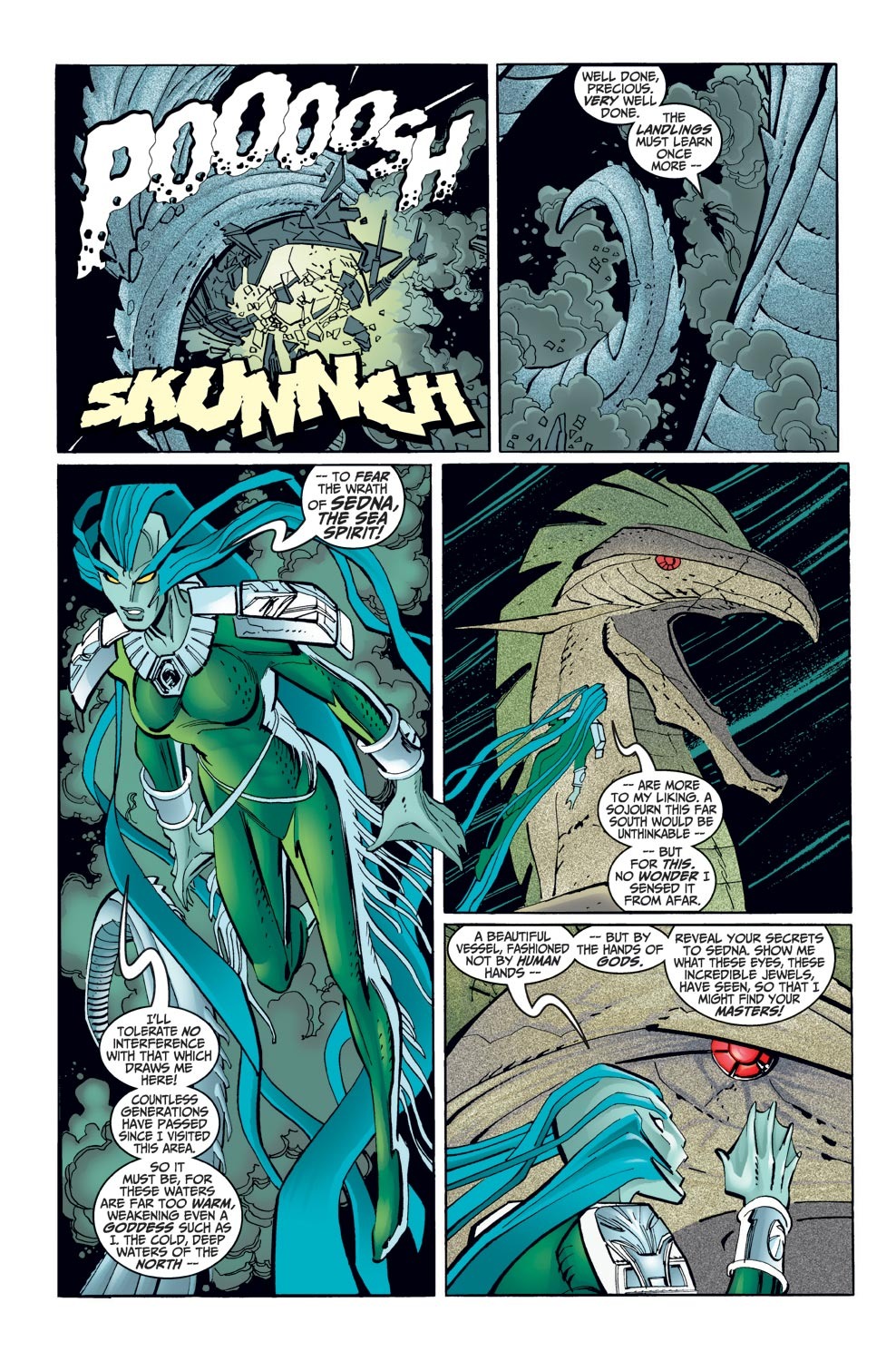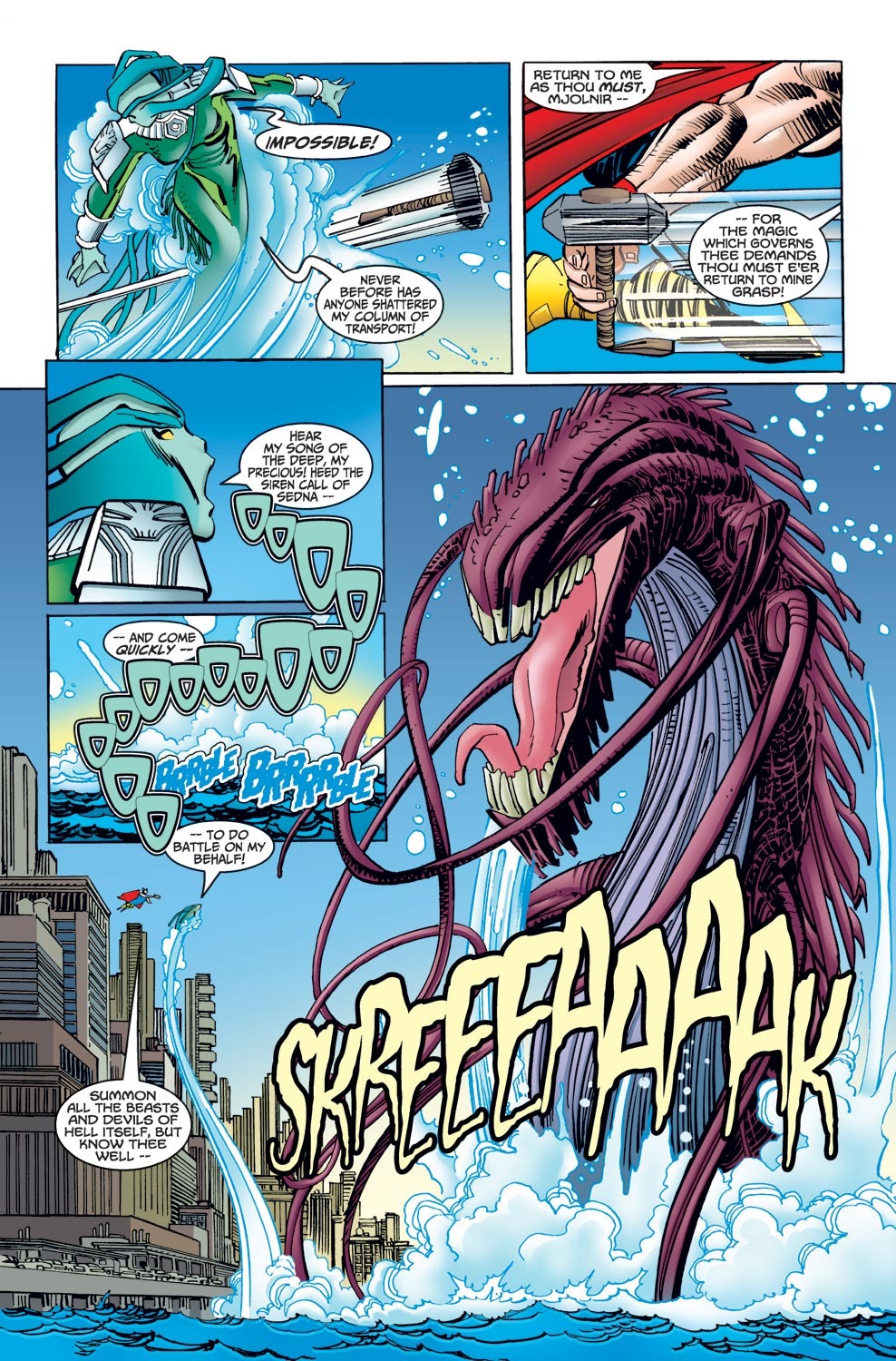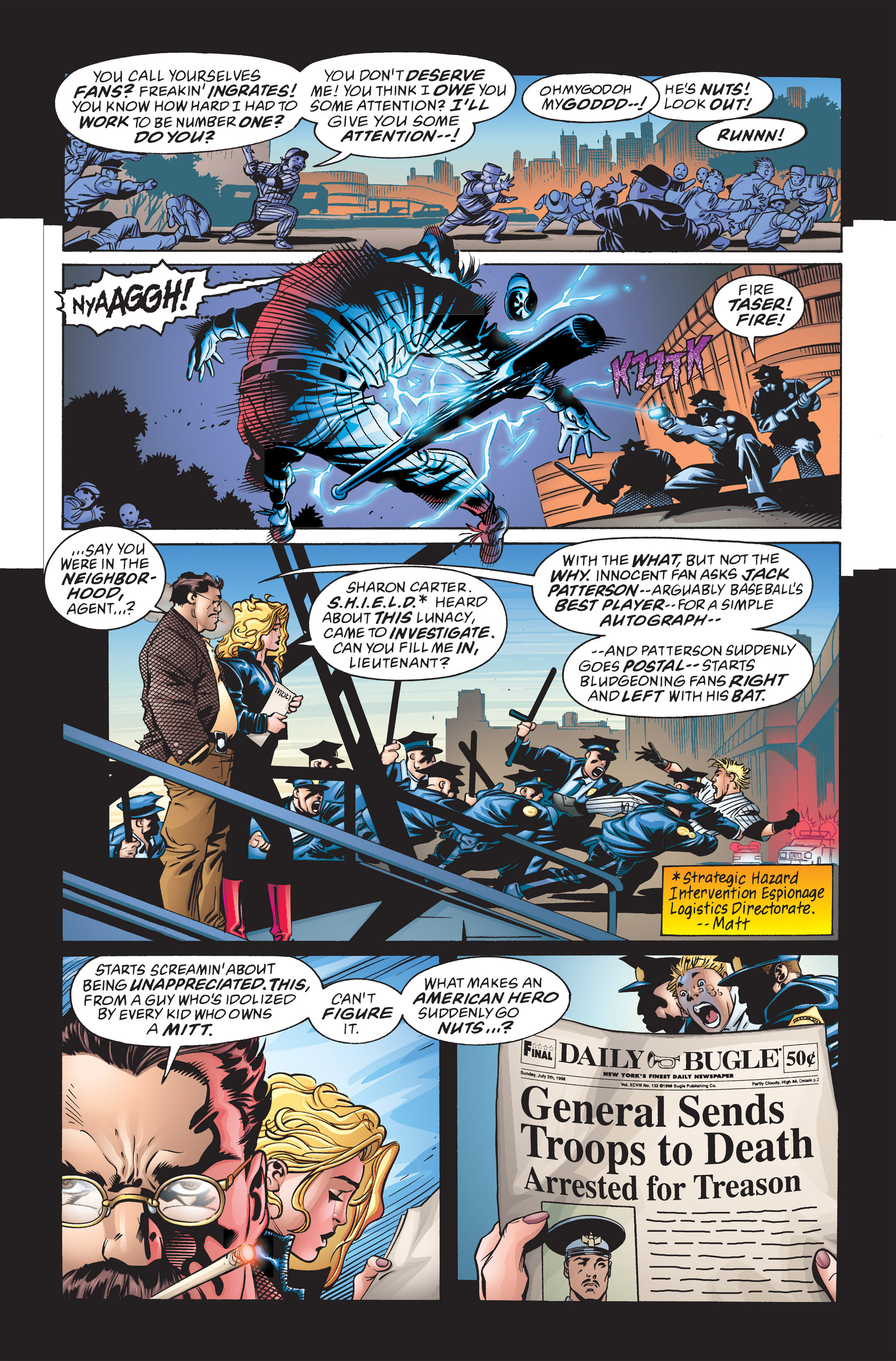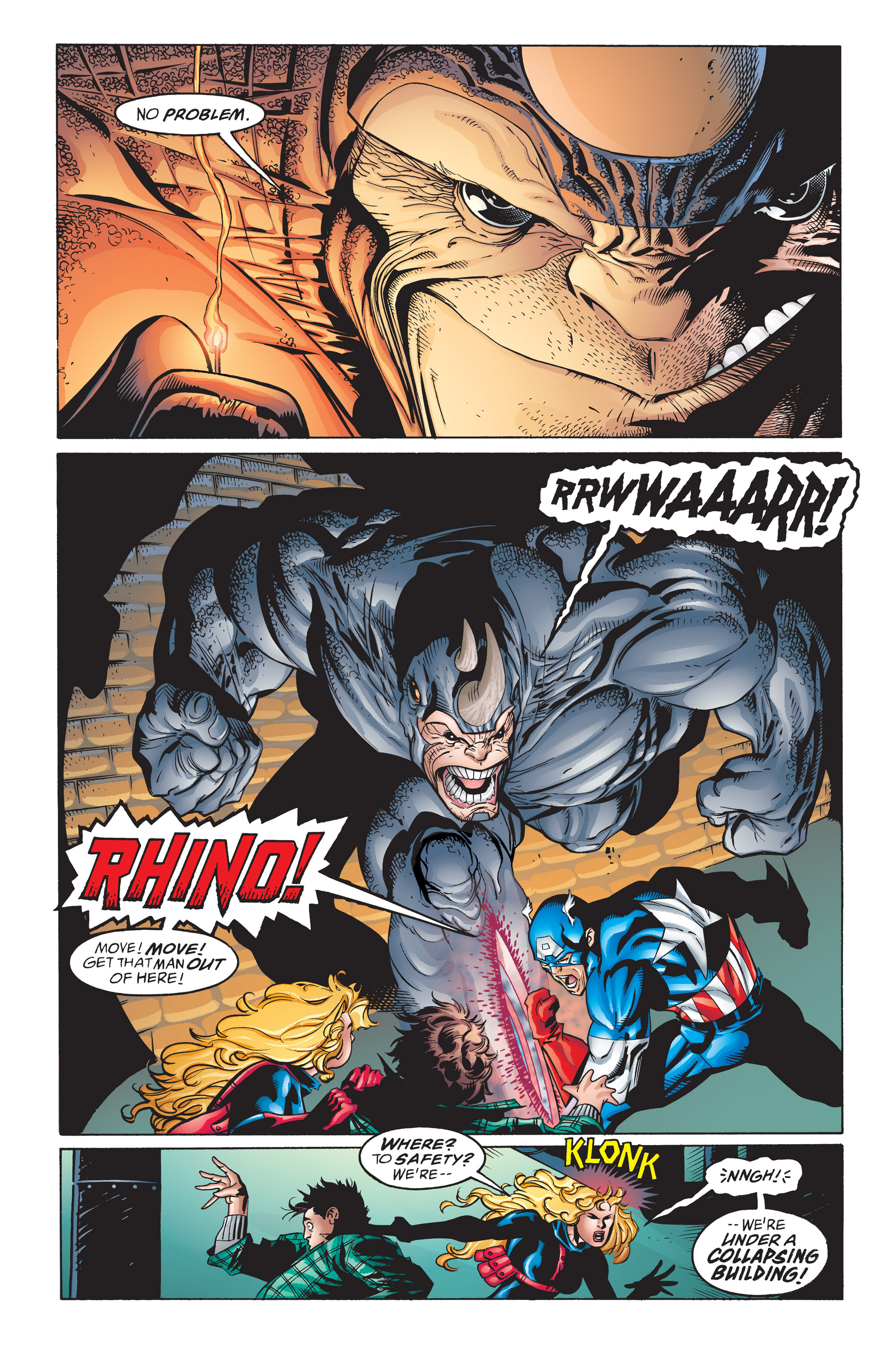Iron Man & Captain America Annual Ď98
This annual is set while Iron Man is still recovering from injuries from a fight with the Mandarin, cowritten by Busiek, Waid and Roger Stern, with art by Patrick Zircher. The collaboration works decently in this particular annual, given its scope. Iron Man and Captain America work together against Modok, while Cap is pissed off that Tony used alien tech to play around with the minds of the world. Itís a legitimately interesting superhero conflict.
It kicks off with a relatively typical Captain America story, where supervillain Mentallo tries to read the minds of everyone on Earth. That draws in Tony Stark, who is able to best him in a battle of minds and then makes everyone in the world forget that heís Captain America. Itís a retcon that creates a new conflict between Tony and Steve, based on their values, kind of a proto Civil War. One detail I like is that Tony Stark got involved because a villain tried to control everyone on Earth telepathically, and Tony Stark happened to one of those people, with precautions against mental takeovers.
This leads to a new mission where Captain America is challenged at his core beliefs. Both missions are pretty decent, with the second story featuring a utopian society founded by someone Tony Stark once had an unpleasant encounter with (As an example of Tonyís psychological depth, he recognizes his mistakes there) targeted by MODOK, who makes a lot of sense for this team-up, since he was introduced in the Captain America comics, but feels right as an Iron Man foe (he was in the cartoon.) MODOK is able to take advantage of the groupmind and may achieve his most powerful form. And it ends with Cap forced to make a difficult decision. This is a model team-up where the conflict is earned, and even when the superheroes save the day, their differences arenít resolved. The main difference is that theyíve lost their initial confidence in their rightness.
A-
Captain America: Sentinel of Liberty #1
It seems a bit weird for Marvel to go with a second Captain America title. Eventually it was established as a 12-issue maxi-series. Originally, it seemed to be a book for Waid and Garney when Kubert took over the other book (in fairness, Captain America was pretty popular with Waid and Garney.)
This title is more of an anthology, outside the usual Marvel time. And it subverts this not by a flashback, but by kicking off in July 4 2001, which is a few years after the publication. That leads to a standard flashback about a story where Sharon Carter (this was before he knew her name) had a secret goal she didnít want to share with Cap. Thatís a moral dilemma that gets explored in the Brubaker era and I guess this is an example of one run walking so another could run. The questions of what Cap is supposed to do as an icon get some interesting development in the next few years, and this is a decent step in that journey.
The villainís a rogue SHIELD agent. He has some decent moments, like when he threatens his former colleagues, even if it is a bit generic (and likely was in 1998.) I do like the idea of an ambitious agent upset that heís an anonymous number, trying to make a name for himself. And the conflict with Cap getting an order to terminate the bad guy, and Sharon Carter refusing to let him do it is a decent one.
The bookends set in the future raise an interesting question: Have the Captain America and Sharon Carter of the current comics reached that stage by now? Are the future sequences now in their past?
B+
Results 76 to 90 of 155
-
02-09-2024, 05:02 PM #76
 Sincerely,
Sincerely,
Thomas Mets
-
02-09-2024, 05:17 PM #77

In fairness, he was also the big bad in the Stan Lee run.
And there are some well-reviewed Mandarin story.
Years ago, I was trying to come up with a list of the best Iron Man stories, and I realized that there were commonalities. Obviously, "Demon in a Bottle" was rated well, along with the Doctor Doom encounters in Iron Man #149-150 and #249-250, Warren Ellis and Adi Granov's opening storyline, Armor Wars, Fraction/ Larocca's first arc, the "World's Most Wanted" follow-up, the relapse in Dennis O'Neil's run and the Iron Monger saga.
Some lists didn't have any Mandarin stories, but most did. They tended to pick different ones. Two websites really liked the Enter the Mandarin mini-series. Some liked a Bill Mantlo/ George Tuska saga which concluded with Iron Man #100. And some liked Mandarin's role in the Director of SHIELD saga.
That's fair. I can definitely see the Mephisto connection.
I still liked the art. (The following pages are not in order.)


 Sincerely,
Sincerely,
Thomas Mets
-
02-12-2024, 03:36 PM #78


Captain America #9-12
Something is convincing accomplished Americans to act in outrageous ways, and that sets up the arc. In the first section, Steve finds a homeless family hiding in his apartment, and tries to get the father a job at a construction site, where the guy in charge has a breakdown and hires the Rhino for some insurance fraud. This leads to an impressive set piece with Captain America, Sharon and a civilian trapped under wreckage.

The story is a bit episodic. Another challenge includes a showdown with a former ally. Thereís an impressive action scene where Cap has to prevent a plane from going off, but the showdown itself is a bit of a letdown, even as a small part of the larger story.
The theme of a twisted American dream fits Cap, as well as the Dr. Strange villain brought over the arc (Itís Nightmare- Itís not a particularly important 25 year old spoiler.) It sets up an apocalyptic challenge with Captain America in the world of nightmares and someone possessing his body (which has been an element of some of my favorite Captain America stories, so I donít really mind even if the idea of someone evil who looks like Cap is a bit played out.) The story is a bit self-consciously inspirational, but it fits the character and the context of a story about nightmares and dreamers.

Kubertís art is exciting. I completely see why he was one of the most popular artists in comics at this time. He helps sell the outrageous big moments, and captures different settings (dreamscapes, military bases, an apartment building full of love) quite well.
B+Sincerely,
Thomas Mets
-
02-13-2024, 05:51 AM #79

That Sentinel of Liberty issue was actually the very first Captain America comic I ever read when I was a kid. I remember picking it up at my local Books a Million store because the cover of the comic looked dynamic and cool. I knew nothing of Captain America back then. I still have it in my closet. Good memories from my childhood.
-
02-13-2024, 03:57 PM #80

Thunderbolts #19
The Thunderbolts arenít finding much public support as superheroes, and considering an offer to go back to crime when local teens tell them about a conspiracy involving a militia backed up by a monster: Charcoal the Burning Man. He was created in a Wizard contest, so this is a decent title for that character to pop up in.
One thing I like about the series is that the characters are struggling to do the right thing, and the temptation is real. Jolt has an outburst that seems reasonable for a teenager realizing the world is more complex, but that the rest of the team is giving up way too easily. This is a team book with some decent conflicts. Itís a satisfying single issue story that fits the larger arc, and where the Thunderbolts are at this stage.
Comics at this time seem to be shifting to a different type of storytelling. At this point the norm is dense shorter stories where itís ordinary for a superhero team to have a single issue adventure. Soon, the norm will be TPB-length cinematic epics, with single issue stories focusing on solo adventures, bystanders or set-up to something coming later. That leads to some good comics, and the consensus is that superhero comics generally get better in the 2000s than in the 90s, but I could see why fans of a certain type of team book were so grouchy about the shift to writing for the trade.
A
The Avengers #10-11
This two-parter feels like a Silver Age annual. The public celebrates Avengers Day, a big celebration in New York City that gets the attention of celebrities and Marvel superheroes. Wanda goes to confront Agatha Harkness about Wonder Manís irregular return from the dead, and his brother- the Grim Reaper- brings Avengers back from the dead in an effort to punish the team, setting the current Avengers against their fallen comrades.
Wandaís arc is the most significant, setting up the return of Wonder Man, her realization that she loves him and new developments in the love triangle with the android his brain patterns are based on. Itís one of the best superhero resurrections because it is so well earned. This was not intentional at the time, but Wandaís increased powers fit later developments in Avengers: Disassembled pretty well. It echoes nicely that the developments in the first Avengers story of this period lead to the end of the era.
There are so many small moments that I like. One recurring bit is the has-been media types doing color commentary for Avengers Day, and one of them tries to save the day from a supervillain plot. Busiek uses narration really well, like when Wanda is absorbed with her own problems and completely unaware that Grim Reaper defeated her team-mates. I love that thereís a sequence of villains responding to a news item about the Avengers, and one of them is the Grim Reaper, except heís going to attack them a few pages later.
George Perez is fantastic on the book, and this is one of his best stories, thanks to all the cameos, the epic battles with Dead Avengers and excuses to depict classic moments. It might be a bit too easy for the Grim Reaper to bring people back from the dead, but the results are excellent.
ASincerely,
Thomas Mets
-
02-14-2024, 06:00 AM #81

When did Wonder Man die again?
"Cable was right!"
-
02-14-2024, 09:54 AM #82

A great era of storytelling. Busiek/Perez were the business. Kang Dynasty and Ultron Unlimited were both incredible. I am also a huge fan of the Dan Jurgens run on Thor. It gets overlooked by the JMS relaunch in 2007 (which was good), but I think it can be argued that Jurgens' run was, at worst, one of the 3-4 best on the character (it's my second favorite). Great storytelling, lots of action and character development. And there were a lot of very good artists with the title.
Generally, the Heroes Return era was really fun, and you could start seeing the shift in storytelling toward the early-2000's as Quesada took over and Marvel Knights and the Ultimate Universe would dramatically alter/influence things.
-
02-14-2024, 09:58 AM #83BANNED

- Join Date
- Jan 2024
- Posts
- 173
-
02-14-2024, 12:03 PM #84
-
02-14-2024, 12:29 PM #85All-New Member

- Join Date
- May 2014
- Posts
- 10

I've been doing a complete Avengers reread and am just working through Disassembled.
When I got to Heroes Return I expanded out to Captain America, Iron Man & Thor.
All four books are solid relaunches and far superior to Heroes Reborn though Avengers is the jewel in the Crown.
Iron Man goes off the rails first, after Busiek leaves its close to unreadable for the rest of the run.
Captain America is strongest under Waid but holds together reasonably well after that. The 2002 relaunch was not to my taste though the art is decent.
Thor is pretty solid all the way through the Jurgens run and he keeps it interesting.
Avengers is obviously excellent for pretty much the whole Busiek run though personally I find Kang Dynasty a bit unfocused. The Perez and Davis issues plus Forever are amongst my favourite ever Marvel stories.
The Geoff John's stuff doesn't live up to it but is still decent and very readable.
Then the drop off a cliff in quality of the Austen run is quite incredible. It's so poor I'm shocked Marvel published it. If I was, them I'd have scrapped it when they read the first script. It's even worse than his X-Men run.
And then Disassembled which is also horrific, though for different reasons, and the last time I ever collected Avengers regularly. I hated it and the relaunch so much I basically stopped reading Marvel for a decade.
I also included Thunderbolts which is great under Busiek and doesn't falter that much later. Well until the weird revamp with those terrible magazine covers, again I don't know what Marvel were thinking.
Fantastic Four under Claremont starts pretty well particularly with Alan Davis but deteriorates rapidly. The whole Reed pretending to be Doom stuff becomes near unreadable. Once he leaves there's a uptick in quality and of course then Waid comes in for one of the titles better runs.Last edited by VDCNI; 02-14-2024 at 04:21 PM.
-
02-15-2024, 02:51 PM #86

The Thunderbolts #20
The Thunderbolts take on the new Crimson Cowl and Masters of Evil, deciding to make their mark as superheroes. It does not go well. They seem to be saved by Dreadknight, a C-lister who wants to join them, but heís got a secret.
I could easily grade this as a part of a larger saga about the new Masters of Evil, although it makes more sense to go issue by issue, especially considering how this title connects to what;ís going on in other books.
It highlights one thing Kurt Busiek does very well. He takes the strategy of being a superhero differently. Moonstone sees a moment when she might be able to take credit for a victory and that ends up backfiring. Thereís a challenge against her leadership, and it seems like the kind of conversation you could have in a sports or corporate drama. This team is interesting because it hasnít calcified into anything yet. The characters have been on a journey that isnít yet defined the way other long-running series on, so we donít know whoís going to find redemption, and if anyoneís going to fall short.
Iíll note that the team isnít called superheroes. I do like the term ďsuper-fugitivesĒ for a group that isnít supervillains any more, but arenít as respected as the Avengers or even the Defenders.
The new Masters of Evil make sense as recurring villains, and theyíve got personality.
I knew Dreadknight mainly from a mid Spider-Man story, and I had no idea where his arrival was going. It seemed like a potentially interesting dynamic of a villain disappointed in his work trying to seek out a chance at being one of the good guys, and since I donít know offhand what Dreadknightís been up to since 1998, I didnít really know whether heíd join the team, or how that would work. Although thereís a twist to it that I knew was coming, but I didnít know how they would get there. And when it happens, Iím pleased.
A
Captain America & Citizen V Annual Ď98
With Karl and Barbara Kesel helping with plot and script, Kurt Busiek and Mark Bagley feature a showdown between Citizen V and Captain America. Baron Zemo returns to his fatherís headquarters in the Amazon to uncover Particle X, a World War 2 weapon, with Technoí help. The new Citizen V strategizes against him, and is mistaken for the baron by Captain America. Cap quickly realizes whatís going on, we get a flashback with the original Citizen V, and an origin for the new one, before the big team-up complete with strategies, a missile, a heroic sacrifice, a last minute save and an okay status quo for a major villain.
This is a decent idea for an annual, because the story is compelling to readers of Captain America- who presumably like the idea of a showdown between Cap and one of his top enemies- and the Thunderbolts, who want to see what Zemoís up to while his former teammates are facing a different challenge. These team-up annuals didnít always work (I didnít care for the Thor/ Silver Surfer or Amazing Spider-Man/ Devil Dinosaur ones) but this one is a good example of how it could further both series in a story that wouldnít work as well as a Thunderbolts two-parter.
They make good use of the setting, which builds on the characterís history, and makes this comic a little different. I like the conflicts between Baron Zemo and Techno, and itís not about morals, but about patience and whether itís worth doing particular things for appearancesí sake. The flashback story is okay. Iím sold on Citizen Vís Peggy Carter the moment she meets Cap. We seem to get some answers about the new Citizen V, although there are still some mysteries, and with the quality of the story so far, Iím looking forward to it. This is new territory for me, so Iím happy that I donít know whatís happening next or how this is going to resolve itself.
A-Sincerely,
Thomas Mets
-
02-15-2024, 02:56 PM #87

It was a great love triangle.
I do not believe I will be covering that era of Avengers-adjacent comics.
At the time, the Thor run had a reputation as the best since Simonson.
One problem for its reputation is that there are multiple acclaimed Asgard-based runs later: JMS/ Coipel's Thor, Fraction's Thor, Gillen's Journey Into Mystery and Jason Aaron's Thor.
In comparison, this stretch is underappreciated.
I'll probably take this up to Disassembled.
I'll keep going with Thunderbolts until at least the crossover with Avengers #34. At that point, I'll play it by ear and it depends a bit on how much I like Nicezia's run. I'm not really that familiar with him as a writer.
Feel free to comment on any stories in the time period, whether I've got to it or not.Sincerely,
Thomas Mets
-
02-15-2024, 03:08 PM #88BANNED

- Join Date
- Jan 2024
- Posts
- 173
-
02-15-2024, 10:55 PM #89All-New Member

- Join Date
- May 2014
- Posts
- 10

Thunderbolts, if you're going that far then you might as well continue to issue 50 as a lot of the ongoing plots are tied up there.
51-75 aren't as strong but they do set the scene for the Thunderbolts/Avengers mini by Busiek and Nicieza.
Yeah Disassembled probably a good place to stop though Iron Man and particularly Captain America are much improved afterwards.
I'm not a fan of the Bendis Avengers run but it's still a lot better than the Austen Avengers. New Thunderbolts is quite fun as well.
-
02-16-2024, 07:28 AM #90

The Zemo/Techno alliance was fun to watch. Especially with how Zemo viewed it from behind Techno's back. And it seemed Techno kept upgrading and changing his robot body in new twisted, hulking ways. I like how he's drawn in so many different forms, he's literally like "this isn't even my final form" Good stuff from the classic Thunderbolts.




 Reply With Quote
Reply With Quote




